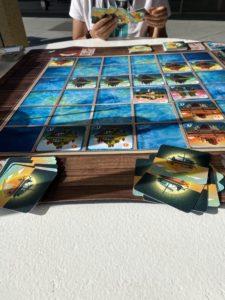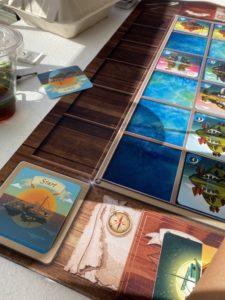Game: Tranquility by James Emmerson and Tristam Rossim on Luck Duck Games (rulebook)
Tranquility’s theme is tranquility from silence. In a nutshell, tranquility is a number puzzle game with beautiful graphics rather than a themed game. The pattern of interaction in the game is player vs game where players try to fill up the game board completely before one of the players runs out of cards to put down. Two important aspects of Tranquility are: 1) fill up the board in the sequential order from the bottom left to the top right 2) use the cards wisely so that cards don’t run out quickly.
Tranquility’s mechanics emphasize these aspects. Most notably, it is completely silent. Players can use facial expressions or gestures to communicate. This mechanic makes the first aspect of the game more challenging. Another mechanic is discarding cards every turn. This means that if players continue to put down cards that have larger differences compared to their neighboring cards, they will burn through their deck quickly and likely lose the game. Start and finish cards are other important mechanics. If everyone discards their finish cards during the discard due to a start card, everyone loses.
The game promise a couple of types of fun. First, its beautiful visual design provides visual appreciation. Secondly, the game provides fun through richly practicable mechanics. The game itself is easy to learn as long as you know how to count and subtract. However, by adding mechanics like silence and discarding cards, the game allows more randomness and difficulty. Therefore, it is difficult to feel like you’ve “mastered” the game and win all the time.
Ironically, even though I praise their visual design so much, I don’t think the design has a direct correlation with the types of fun the game provides other than the visual appreciation. The visual design depicts islands in a sea and each card has drawings of islands in two versions (night and day). However, the design doesn’t correlate with the mechanics and fun of the game.
The game differentiates itself mostly with the visual design and the number subtraction mechanic. The game is also different from other number-puzzle games since it is a player vs game and players fill in the board with numbers in sequential order. This is very different from games like Racko or Uno, number games that don’t encourage communication between players.
Tranquility has little room for abuse. The game is silent for tranquility. Since it’s cooperative and silent, there is not a lot of toxic interactions that can occur. Therefore, Tranquility doesn’t really handle abuse.
The first improvement I would make is tying the design and the game. This can be done by adding another objective that would focus on the contiguous island sizes, etc. Tranquility seems easy for players to grow out of the mechanics quickly. Therefore, more twists to relate it to the visual design and another objective with a less consistent nature could improve the game a lot.




